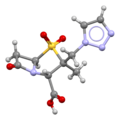Tazobactam
Superficial vein thrombosis (SVT) is a medical condition characterized by the formation of a blood clot in a superficial vein, which is located near the surface of the body. This condition is often associated with inflammation and can lead to complications such as deep vein thrombosis and pulmonary embolism if not treated promptly.
Causes[edit]
The exact cause of SVT is not known, but several factors can increase the risk of developing this condition. These include prolonged immobility, certain medical conditions such as cancer or blood disorders, and certain medications. Smoking and obesity are also risk factors for SVT.
Symptoms[edit]
The most common symptom of SVT is a painful, red, and swollen area along the course of a superficial vein. Other symptoms may include skin discoloration, warmth over the affected area, and a hard vein that can be felt through the skin.
Diagnosis[edit]
SVT is typically diagnosed through a physical examination and medical history. In some cases, an ultrasound may be used to confirm the diagnosis and rule out other conditions such as deep vein thrombosis.
Treatment[edit]
Treatment for SVT typically involves measures to reduce inflammation and prevent the formation of new clots. This may include the use of nonsteroidal anti-inflammatory drugs (NSAIDs), compression stockings, and elevation of the affected limb. In some cases, anticoagulant medications may be prescribed to prevent the clot from extending into the deep veins.
Prevention[edit]
Prevention of SVT involves addressing the underlying risk factors. This may include maintaining a healthy weight, quitting smoking, and managing any underlying medical conditions. Regular exercise and movement can also help to prevent SVT, particularly for individuals who are immobile for prolonged periods.
See also[edit]
Ad. Transform your life with W8MD's Budget GLP-1 injections from $75


W8MD offers a medical weight loss program to lose weight in Philadelphia. Our physician-supervised medical weight loss provides:
- Weight loss injections in NYC (generic and brand names):
- Zepbound / Mounjaro, Wegovy / Ozempic, Saxenda
- Most insurances accepted or discounted self-pay rates. We will obtain insurance prior authorizations if needed.
- Generic GLP1 weight loss injections from $75 for the starting dose.
- Also offer prescription weight loss medications including Phentermine, Qsymia, Diethylpropion, Contrave etc.
NYC weight loss doctor appointmentsNYC weight loss doctor appointments
Start your NYC weight loss journey today at our NYC medical weight loss and Philadelphia medical weight loss clinics.
- Call 718-946-5500 to lose weight in NYC or for medical weight loss in Philadelphia 215-676-2334.
- Tags:NYC medical weight loss, Philadelphia lose weight Zepbound NYC, Budget GLP1 weight loss injections, Wegovy Philadelphia, Wegovy NYC, Philadelphia medical weight loss, Brookly weight loss and Wegovy NYC
|
WikiMD's Wellness Encyclopedia |
| Let Food Be Thy Medicine Medicine Thy Food - Hippocrates |
Medical Disclaimer: WikiMD is not a substitute for professional medical advice. The information on WikiMD is provided as an information resource only, may be incorrect, outdated or misleading, and is not to be used or relied on for any diagnostic or treatment purposes. Please consult your health care provider before making any healthcare decisions or for guidance about a specific medical condition. WikiMD expressly disclaims responsibility, and shall have no liability, for any damages, loss, injury, or liability whatsoever suffered as a result of your reliance on the information contained in this site. By visiting this site you agree to the foregoing terms and conditions, which may from time to time be changed or supplemented by WikiMD. If you do not agree to the foregoing terms and conditions, you should not enter or use this site. See full disclaimer.
Credits:Most images are courtesy of Wikimedia commons, and templates, categories Wikipedia, licensed under CC BY SA or similar.
Translate this page: - East Asian
中文,
日本,
한국어,
South Asian
हिन्दी,
தமிழ்,
తెలుగు,
Urdu,
ಕನ್ನಡ,
Southeast Asian
Indonesian,
Vietnamese,
Thai,
မြန်မာဘာသာ,
বাংলা
European
español,
Deutsch,
français,
Greek,
português do Brasil,
polski,
română,
русский,
Nederlands,
norsk,
svenska,
suomi,
Italian
Middle Eastern & African
عربى,
Turkish,
Persian,
Hebrew,
Afrikaans,
isiZulu,
Kiswahili,
Other
Bulgarian,
Hungarian,
Czech,
Swedish,
മലയാളം,
मराठी,
ਪੰਜਾਬੀ,
ગુજરાતી,
Portuguese,
Ukrainian




